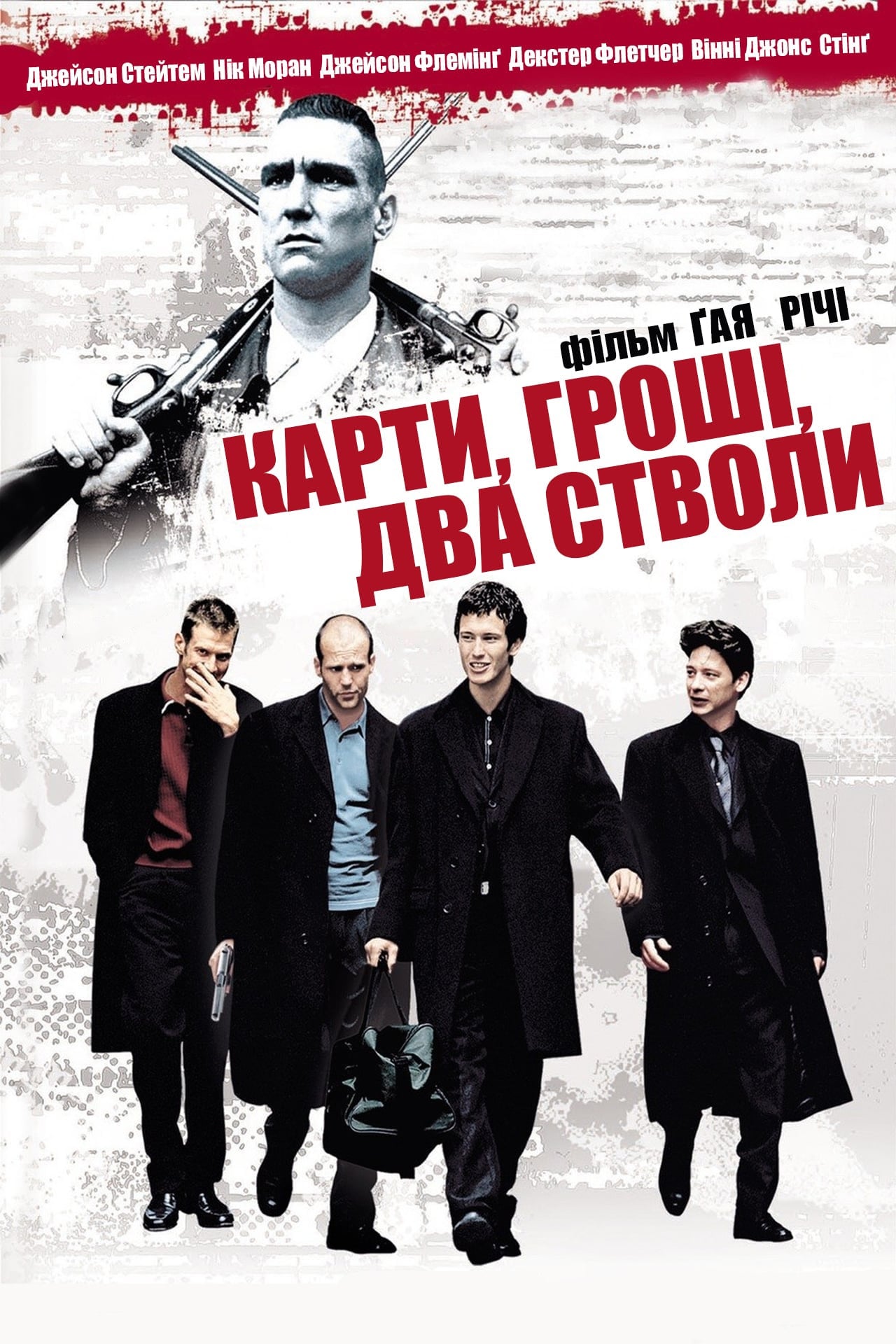Spoilers:
- The drugs end up with Scousers.
- Eddy and friends owe money fast.
- Guns are accidentally discarded.
- Crime boss wants his money back.
- Neighbor’s heist gets interrupted.
- Bacon and Tom save the day.
- Everything leads to chaos, of course.
Lock, Stock and Two Smoking Barrels: Statistics
A British crime thriller. Directed by Guy Ritchie.
Film Details
- Release Year: 1998
- Genre: Crime, Thriller
- Director: Guy Ritchie
- Running Time: 107 minutes
Box Office and Production
- Budget: $1.35 million
- Box Office: $28.1 million
Cast Overview
- Jason Flemyng as Tom
- Dexter Fletcher as Soap
- Nick Moran as Eddy
- Jason Statham as Bacon
- Vinnie Jones as Big Chris
Reception
- Rotten Tomatoes: 75% approval
- Metacritic Score: 66/100
- IMDb Rating: 8.2/10
Guy Ritchie’s ‘Lock, Stock and Two Smoking Barrels’ is an insouciant symphony of British crime comedy, braiding grim, gritty realism with unapologetic flair. Characterized by peeling wallpaper and cockney slang, this audacious directorial debut dazzles us with its stratified narrative, colorful cast, and an entrancing display of endurance of luck under adversity.Ritchie orchestrates his characters and plotlines much like a ruthless puppeteer, indulging them enough rope and watching them inevitably tangle into a spectacular hobbledehoy of bungled heists and botched plans. Yet, from within the chaos shines a clear motif of kinship and camaraderie amongst the four hapless friends, exposing an emotion-infused substratum of human interconnectedness.Perceptive and provoking, the film presents Richie’s kaleidoscopic view of London’s underworld, a seedy kaleidoscope of dubious morality. Visual storytelling is prominent, humor being the velvet glove around the iron fist of violence, a dualism made poignant through gripping cinematography.Ritchie’s unforgivable characters mesmerize us; they are not painted as villains or heroes but rather fallible humans oscillating between blind ambition and survival instinct. Their dialogue, replete with trademark British humor and expletives, resonates with a raw authenticity that’s both outrageous and deeply human.Simultaneously brilliant and brutal, ‘Lock, Stock and Two Smoking Barrels’ sees Ritchie introducing his distinctive storytelling approach. While eking out each individual’s story, he shrewdly leads us through a labyrinth, until all paths converge in a chaotic vortex, which humorously shrugs at the concept of consequence.Emotionally charged with a heady mix of despair, aspiration, foolishness, and inevitable comeuppance, the film delivers an incisive commentary on human folly. Pivoted around desperations and dreams of ordinary men caught in extraordinary circumstances, Ritchie’s debut is a commendable craftwork of stylized violence and humor. It’s engaging and unpredictable, a whip-smart comedy-crime-drama that warrants—and rewards—its viewers’ intellectual involvement.
Lock, Stock and Two Smoking Barrels
Released in 1998, “Lock, Stock and Two Smoking Barrels” is a British crime-comedy film that quickly became an iconic piece of cinema. Directed by Guy Ritchie, the film launched his career and established his signature style. It combined a gritty London underworld with humor, creating a unique genre blend.
Plot Overview
The movie follows a group of four friends, led by Eddy, who find themselves deep in debt after a miscalculated card game. The story unfolds through a series of interconnected capers, misunderstandings, and a quest involving two antique shotguns.
Interesting Facts
- The budget was a modest £1.35 million. It grossed over £28 million worldwide.
- Former footballer Vinnie Jones made his acting debut in this film.
- Sting, the famous musician, starred as Eddy’s father, JD.
- The film kicks off Guy Ritchie’s career, leading him to direct films like “Snatch” and the “Sherlock Holmes” series.
- The narrative is constructed with fast cuts, sharp dialogue, and a multi-stranded plot.
Speculation and Notable Points
The film is rumored to have influenced a wave of British gangster films. Critics often debate if it glorifies criminal life or satirizes it.
Ritchie’s style, full of quick edits and intertwined storylines, drew comparisons with Quentin Tarantino. However, it holds a distinct British flavor.
Public Perception Over Time
Initially, “Lock, Stock and Two Smoking Barrels” received acclaim. Critics praised its witty script and stylish direction. It quickly gained cult status, especially within British cinema.
Over time, some have critiqued it for potentially glamorizing crime. Yet, many view it as a creative portrayal of London’s street life.
The film’s mix of humor and tension made it a favorite. Rewatchability helped it remain relevant, with new audiences discovering it through home video and streaming. Today, it is often included in lists of must-see British films.
Bizarre Elements
Ritchie’s use of non-linear storytelling and bizarre character names like Soap and Bacon adds a unique eccentricity. The blend of casual violence and humor creates a peculiar tone that’s hard to replicate.
The film’s ending, a cliffhanger involving a ringing phone and questionable fortune, left audiences questioning and discussing possibilities—a hallmark of Ritchie’s narrative mastery.
Lock, Stock, and Two Smoking Barrels: Beat-by-Beat Breakdown
Here’s the lowdown on Guy Ritchie’s 1998 Brit gangster classic, Lock, Stock and Two Smoking Barrels, broken down into its bare-knuckled, beat-by-beat essence.
1. The Setup
Eddy, the sharp operator, and his mates pool £100,000 for a high-stakes poker game against Hatchet Harry, London’s underground boss. Spoiler: It’s a setup. They lose everything, with an extra £500,000 debt to cover. Clock’s ticking; they’ve got a week.
2. The Plan
Next door to the boys, a gang plans to rob some weed growers. Eddy’s crew decides to rob the robbers once they’re done. It’s a simple snatch-and-grab: wait for the heist, then swoop in for the double cross.
3. The Complication
As expected, nothing goes to plan. The weed growers have heavy protection. Meanwhile, Big Chris, Harry’s debt collector, is circling. The boys are dodging threats left and right, and the stakes are skyrocketing.
4. The Twist
Unbeknownst to our lads, the guns they’ve acquired for their heist belong to Harry. These antique shotguns are worth a fortune and could settle their debt. But realization dawns too late—they’re knee-deep in a mess they never saw coming.
5. The Final Confrontation
All threads converge: gangsters, robbers, angry growers, and one very pissed off Harry. Bullets fly, plans crumble, and loyalties are tested. Our boys, now armed and extremely dangerous, attempt to navigate the chaos they’ve sparked.
6. The Resolution
Against all odds, the dust settles. Eddy and his crew find themselves with the cash and the shotguns—sort of. They’re not out of the woods, but they’ve got a fighting chance to right their wrongs. If they can survive a little longer, that is.
7. The Cliffhanger
Our final beat leaves us hanging by a thread. The shotguns, their golden ticket out of this mess, dangle perilously over a bridge. It’s a literal, and figurative, cliffhanger. Will they hold on, or will it all tumble into the Thames?
In a nutshell, Lock, Stock and Two Smoking Barrels is a gritty, fast-paced rollercoaster through London’s underbelly, with twists, turns, and a truckload of laughs. Ritchie’s debut is a stylish, snappy journey into the lives of small-time crooks with big-time problems.

Understanding Lock, Stock and Two Smoking Barrels
Story Opening
The film opens with a fast-paced introduction to its gritty world. You get thrown right into the chaos of London’s underground, marked by quick cuts, colorful characters, and sharp dialogue. The opening sets the tone – this is going to be a film brimming with unpredictability and dark humor. The protagonist, Ed, is introduced as he gears up for a high-stakes card game, hinting at the overarching theme of risk and consequence.
Story Formula Breakdown
The story follows a classic setup of interconnected plots. Here’s the breakdown:
- Beginning: Ed and his friends prepare for the card game with a notorious gangster.
- Inciting Incident: Ed loses a massive bet to the gangster, putting his life on the line.
- Rising Action: The trio devises a plan to get quick cash by robbing a nearby drug dealer.
- Climax: The heist goes wrong, leading to unexpected confrontations with various players in the criminal world.
- Falling Action: Chaos ensues as all characters’ plots intersect in a dramatic conclusion.
- Resolution: The aftermath leads some to triumph, while others face dire circumstances.
Character or Story Driven?
The film is more character-driven than story-driven. Each character has a unique personality that influences their choices and shapes the plot. Their distinct traits and arcs create the tension and humor that drive the narrative forward.
Memorable Characters
What makes the characters memorable is their eccentricity and flaws. They are not just archetypes; they’re quirky, relatable, and, at times, utterly ridiculous. Their decisions often lead to humorous and unexpected results, making them stand out. Their interactions are loaded with wit and tension, which adds depth and complexity to the film.
Main Characters Brief Description
- Ed: The main protagonist, a naive but ambitious young man who finds himself in over his head. His growth occurs as he confronts the harsh realities of the criminal underworld.
- Tom: Ed’s loyal friend, he provides comic relief with his over-the-top plans and reckless attitude. He’s ambitious but often lacks foresight.
- Barry: The group’s resident “weapons expert,” Barry has a quirky obsession with firearms. His character adds a dark humor element.
- Paul: The wise-cracking strategist of the group. He balances the crew’s reckless behavior with a more practical approach to their schemes.
- Dog: The gangster’s loyal pet, a symbol of the brutality in the film. Unique in its characterization, it provides a darkly comedic twist to the narrative.
- The Gangster (Harry): A ruthless, cunning character who embodies the dangers of the criminal world. His presence drives the conflict and adds tension to the story.
Template for Writing This Story Flow
Here’s a simple template that reflects the flow of “Lock, Stock and Two Smoking Barrels”:
- Introduce Main Character: Set the stage with their mundane life and aspirations.
- Introduce Conflict: Present an inciting event that turns their life upside down.
- Formulate Plan: Show the protagonist and their friends planning a desperate scheme to get out of trouble.
- Execute Plan: Detail the attempt, filled with humor and unpredictability.
- Interconnect Storylines: Allow other characters to intertwine with the main plot as their stories collide.
- Climactic Confrontation: Build towards the biggest conflict where all plots converge, revealing twists and consequences.
- Resolution: Wrap up the story, revealing which characters succeed or fail and the lessons learned.
What is the Story About?
In simple terms, “Lock, Stock and Two Smoking Barrels” is about a group of friends who get caught up in a high-stakes game of chance and crime. They face the dire consequences of their choices while navigating an intricate web of interconnected plots and colorful characters. It’s a darkly comedic look at ambition, loyalty, and survival in the gritty underbelly of London.
Inciting Incident
The inciting incident of Lock, Stock and Two Smoking Barrels occurs when Eddie loses £500,000 in a high-stakes card game against the local mobster, Hatchet Harry. This cataclysmic event forces Eddie and his friends into a desperate situation, setting the entire plot in motion.
Symbolically, the card game represents the gamble of life. Eddie’s loss reflects the harsh realities of their world—risk and reward are intertwined. It signifies the characters’ descent into chaos as they try to recover their lost money, illustrating themes of chance, consequence, and survival.
Act Structure
The film follows a typical three-act structure:
- Act 1: Introduction of characters and their ordinary lives, leading to the high-stakes poker game. The inciting incident occurs here with Eddie’s loss.
- Act 2: Eddie and his friends devise a plan to retrieve the money. The plot thickens with various subplots weaving in and out, like the two hitmen and the theft of the guns. Tension builds as their plan begins to unravel.
- Act 3: The climax hits when all characters converge during the final showdown, resulting in chaos. The resolution involves unexpected twists, revealing the consequences of everyone’s actions.
Climax
The climax occurs during the final confrontation where all storylines collide. The emotional capital is high; viewers feel a mix of anxiety and anticipation. Key characters confront each other, and the stakes have never been higher.
The build-up includes multiple moments of tension—Eddie’s increasing desperation and the hitmen’s relentless pursuit. Each character’s actions lead to this explosive moment, making it feel inevitable yet surprising.
Tension and Release
The movie builds tension through quick cuts, overlapping storylines, and escalating stakes. Each scene adds layers of complexity; the audience is constantly on edge. Juxtaposing comedy with dark elements amplifies the anxiety.
Release comes unexpectedly during moments of humor or sudden action. The comedic relief offers a breather, only to pull viewers back into tension as new problems arise. This push and pull keeps the audience engaged throughout.

Lock, Stock and Two Smoking Barrels Ending Explained
The ending reveals that Eddie, the main character, ends up in a high-stakes poker game where he and his friends owe a lot of money to a crime boss. They accidentally acquire two very valuable antique guns, which connects all the characters and plot points. By the end, they confront the violent consequences of their actions, but things twist when a group of gangsters gets involved, leading to a chaotic but neatly wrapped conclusion where everyone’s fate is tied together. The last shot shows Eddie returning to the poker game, suggesting a continuation of the cycle of crime and misadventure.
Writers’ Categorization of the Ending
It can be categorized as a twist ending. The resolution is unexpected but crucial to the plot’s development. It leaves viewers with mixed feelings about morality and consequence.
Symbolic, Thematic, and Speculative Meanings
- Symbolic: The guns symbolize power and the dangerous allure of crime.
- Thematic: Themes of friendship, betrayal, and the unpredictability of life are prevalent.
- Speculative: It raises questions about fate and whether one can escape their past or the cycle of crime.
Loose Ends and Payoffs Resolved
The ending ties together various subplots, such as the debts, the crime families, and the impact of their choices. It resolves the mystery of the antique guns and clarifies how all characters are interlinked, showcasing the unpredictability of their lives.
Character Changes by the End
Characters evolve throughout the film. Eddie grows from a naive hustler to a more hardened individual, learning the harsh realities of the criminal world. His friends show loyalty but also the peril of being entangled in crime.
Lessons for Writers
Writers can learn the importance of interconnected stories. Every character and plotline should serve the main theme and lead to a cohesive resolution. The twist at the end can keep audiences engaged but must feel earned and make sense in retrospect.
Dialogue Style in Lock, Stock and Two Smoking Barrels
The dialogue in “Lock, Stock and Two Smoking Barrels” is fast-paced, witty, and often laced with British slang. The characters engage in banter that reveals their personalities quickly and effectively. The dialogues are character-driven and packed with humor, creating a unique rhythm throughout the film.
Quintessential Character Moment
A quintessential moment is when the character Eddy, played by Nick Moran, lays out the plan to win money through poker, showcasing both hope and naivety. This encapsulates the film’s essence—ambition tinged with desperation.
Iconic Lines
- “This is the start of a beautiful friendship.”
- “You’ve got to ask yourself one question: ‘Do I feel lucky?’ Well, do you, punk?”
- “If you want to know what a man’s like, take a good look at how he treats his inferiors, not his equals.”
Uniqueness of the Dialogue
The dialogue stands out due to its blend of humor and rawness. Characters often speak over each other, mimicking real-life conversations where interruptions are common. The use of local dialects and slang gives it an authentic British feel that adds depth to the narrative.
Dialogue Density
The script is dialogue-heavy. Characters are consistently trading words, often at breakneck speed. This not only develops the story but also keeps viewers engaged through sharp exchanges.
Realism of the Dialogue
While it enhances entertainment, the dialogue is grounded in realism. It captures the essence of street life in London and the culture of the characters involved, making it relatable to the audience.
Lessons for Writers
- Use dialogue to reveal character traits and motivations.
- Combine humor with tension in conversations.
- Embrace interruptions for a more natural flow.
- Incorporate local dialects to enhance authenticity.
Scene Walkthrough
Consider the scene where Eddy explains the poker game to his friends. The rapid-fire exchanges paint a picture of their personalities:
Eddy: “Right, lads, we’re going to play poker.” (Quickly interrupted)
Tom: “We? You mean you. I’ve no idea what I’m doing.” (Eddy brushes him off)
Eddy: “Just keep your cards close, and don’t let them see your hand!”
This scene illustrates the comedic tension and sets the stakes, while showcasing each character’s varying levels of confidence and street smarts.
Curved Fate
In a stoic game of chance,
Four men, a table, a glance,
Bricks and bruises, luck unfurls,
The streets—a canvas, their life twirls.
Two pieces, smoke, and fire,
A dance of greed, a heartfelt choir.
Currency burns, patience wears,
In shadows cast, the past ensnares.
Like clockwork with a rusty key,
Twists in plot, absurdity.
What’s left of gold, dusty dreams,
In alleyways, nothing seems.
Random fate, and luck’s embrace,
A madman’s grin, the weary face,
Stolen glory and tangled threads,
In the smoke of bullets, common dread.
Yet in the chaos, a moment clear,
Brotherhood’s warmth, amid the sear.
With every twist of fate’s rough hand,
They rise, they fall, as destinies strand.
Writing Lessons from Lock, Stock and Two Smoking Barrels
Guy Ritchie’s debut film packs a punch not only in its storytelling but also in its writing techniques. Here are some unique insights to consider:
-
Simplify, Don’t Overcomplicate
Ritchie streamlines his plot. The narrative unfolds clearly, without unnecessary subplots. Every scene counts.
-
Use Dialogue Creatively
Characters’ banter is sharp and reveals personality. Dialogue drives the story forward. It’s not just filler.
-
Character Driven Stories
Focus on strong, memorable characters. Their quirks and goals make the story engaging, not just the plot twists.
-
Interwoven Stories
Different characters’ arcs intertwine seamlessly. This layering enhances the narrative without confusing the audience.
-
Subvert Expectations
Ritchie’s twists redefine typical crime genre tropes. Lead your audience down a predictable path, then flip it on its head.
-
Visual Style as Narrative
The film’s visual flair isn’t just for show. It reinforces the tone and themes, turning visuals into storytelling tools.
-
Build Tension Effectively
Tension mounts through pacing and timing. Know when to escalate and when to let a scene breathe.
-
Grounded Realism Amid Absurdity
The absurdity of the plot works because it’s set in a relatable world. Balance the extraordinary with the familiar.
-
Craft a Strong Opening
The film hooks the audience from the start. An engaging opener sets the tone and grabs attention immediately.
-
Music as Narrative Layer
Soundtrack choices complement scenes. Use music not just for mood, but as a narrative device that enhance emotions.
Guy Ritchie’s Films
Guy Ritchie is known for his sharp, gritty films that often include elements of crime and dark humor. Here’s a brief overview of his notable works:
- Lock, Stock and Two Smoking Barrels (1998) – A British crime caper that explores the intertwining lives of four friends who venture into the criminal underworld.
- Snatch (2000) – Another crime film that revolves around the conflicts between two groups of criminals over a stolen diamond.
- Revolver (2005) – A psychological thriller that focuses on themes of power and manipulation within the underworld.
- RocknRolla (2008) – A tale of a chaotic London underworld, infused with Ritchie’s unique style and humor.
- Sherlock Holmes (2009) – A fresh take on the iconic detective story, blending mystery with action and humor.
- Snatch (2021) – A return to form with interconnected stories of crime and chaos.
- Aladdin (2019) – A live-action remake of the animated classic, showcasing Ritchie’s flair for vibrant storytelling.
Writing Style
Ritchie’s style is characterized by fast-paced dialogue, intricate plots, and a blend of dark humor and crime.
Review 1: Excerpt: “Lock Stock and Two Smoking Barrels shot Richie into the spotlight, arriving on the back of a wave of Cool Britannia themed films and bands. Its fast, kinetic energy, cheeky dialog, memorable characters and enthralling mishaps proved to be a hit with audiences and critics alike. Lock Stock is a timeless piece of British Cinema that hasn’t lost any of its rough and ready charm or unique style.”Link: https://whatculture.com/film/10-reasons-lock-stock-and-two-smoking-barrels-is-a-british-classicReview 2:Excerpt: “The story is complicated, but really simple: We follow four friends who are serious card players, and watch as they gather their savings together to stake their friend Eddy for a high-stakes game. What happens during the game is one of those movie narratives that doubles back on itself like an Escher staircase.”Link: https://www.rogerebert.com/reviews/lock-stock-and-two-smoking-barrels-1999Review 3:Excerpt: “Ritchie’s thriller was giddy fun, a load of Cockney rhyming slang, and a twist-driven plot, exploding with energy and oddball characters. Moments of heavy violence rubbed shoulders with humorous and surreal sequences, a hyper-stylized fable that felt both fresh and dynamically engaging.”Link: https://www.filmink.com.au/review/lock-stock-and-two-smoking-barrels-4k-uhd-blu-ray/Review 4:Excerpt: “an intricate puzzle of a movie that’s all the more enjoyable because you can never quite see how the pieces will fit together.”Link: https://www.tvovermind.com/lock-stock-and-two-smoking-barrelsReview 5:Excerpt: “The plot is a labyrinth of twists and turns which Ritchie handles skilfully. This is an excellent, original British movie that defies the usual categories and comes out a winner.”Link: https://www.bbc.co.uk/films/2000/11/08/lock_stock_1988_review.shtml
- Lock, Stock and Two Smoking Barrels – Wikipedia
- Lock, Stock and Two Smoking Barrels (1998) – IMDb
- Lock, Stock, and Two Smoking Barrels (1998): Rory’s story …
- A revisit of Lock, Stock And Two Smoking Barrels suggests maybe …
- [film] IIL Guy Ritchie movies (Snatch, Rocknrolla, Lock Stock & Two …
- Lock, Stock & Two Smoking Barrels (Widescreen … – Amazon.com
- Lock, Stock and Two Smoking Barrels (1998) is wild : r …
- Simon Hayes | Working with Guy Ritchie @guyritchie is always a …
- Recently Rewatched ‘Lock Stock and Two Smoking Barrels’ : r …
- I’m Sorry But Guy Ritchie’s First Movie Is Better Than Quentin …




Leave a Reply